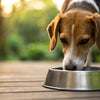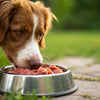Is Raw Dog Food High in Fat? Understanding the Nutritional Landscape
- Houndsy
Table of Contents
- Introduction
- The Composition of Raw Dog Food and Its Fat Content
- How Fat Functions in a Dog's Diet
- Understanding the Variations Among Different Raw Dog Food Brands
- The Relationship Between Fat and Protein in Raw Diets
- Potential Risks Associated with Feeding High-Fat Raw Diets
- Tips for Evaluating and Selecting Raw Dog Food
- Conclusion
Introduction
Did you know that nearly 50% of dogs in America are classified as overweight or obese? This startling statistic from the Association for Pet Obesity Prevention reflects a growing problem facing our canine companions. As dedicated pet owners, we are often tasked with managing our dogs' diets to maintain their health and well-being. One common query that arises is: "Is raw dog food high in fat?"
The rise of raw dog food diets, which emphasize unprocessed meats, bones, fruits, and vegetables, offers a fresh perspective on canine nutrition. You might be wondering how these diets stack up in terms of fat content and how that can affect your furry friend. In this blog post, we aim to provide a comprehensive exploration of raw dog food's fat content, helping you make informed choices about your dog's diet.
By the end of this article, you will gain insights into the nutritional implications of feeding your dog raw food with an emphasis on fat content, protein ratios, and how to navigate the landscape of differing raw dog food brands. We will also address potential risks and benefits associated with raw feeding, ensuring you leave equipped with the knowledge needed to fine-tune your dog’s feeding regimen.
Let's delve into the specifics! We will cover the following aspects:
- The composition of raw dog food and its fat content
- How fat functions in a dog's diet
- Understanding the variations among different raw dog food brands
- The relationship between fat and protein in raw diets
- Potential risks associated with feeding high-fat raw diets
- Tips for evaluating and selecting raw dog food
As we embark on this journey into canine nutrition, we encourage you to reflect on your own feeding practices: Are you considering switching to a raw diet? How do your choices impact your dog's health and weight?
The Composition of Raw Dog Food and Its Fat Content
Raw dog food typically consists of a mix of animal meats, bones, organ meats, and vegetables. When pondering the question, "is raw dog food high in fat?", we must first look closely at the components of these diets.
Key Ingredients in Raw Dog Food
-
Muscle Meat: A primary source of protein that can vary in fat content depending on the type of meat. For example, lean meats like chicken and turkey have lower fat content compared to fatty meats like lamb and beef.
-
Raw Meaty Bones (RMBs): These are essential in a raw diet and contribute to both protein and fat content. Depending on the cut, some RMBs can be quite fatty.
-
Organ Meats: Such as liver and kidneys, organ meats are nutrient-dense and can also contribute fat to the overall diet.
-
Vegetables and Fruits: Often included for vitamins and minerals, these usually contain minimal fat but can be beneficial for overall health.
Analyzing Fat Levels in Raw Dog Food
The fat content of raw dog food can significantly vary based on the ingredients used. Some commercial raw food diets may list fat content on their packaging as a minimum percentage. It's essential to note that these numbers might not always reflect the actual fat levels, as manufacturers often underreport fat content. For instance, a product listing 8% fat may actually contain 18% fat.
To better gauge the fat content in raw dog food, we can use a range:
- Lean Meat Options (e.g., chicken, turkey): 5-10% fat
- Moderate Fat Options (e.g., duck, rabbit): 15-20% fat
- High Fat Options (e.g., lamb, pork): 20% or more
For anyone considering transitioning to a raw diet, we recommend carefully monitoring the specific fat content of each product, especially if you notice changes in your dog’s weight or health.
How Fat Functions in a Dog's Diet
Fat plays a critical role in a dog's diet, serving various functions:
Energy Source
Fat is a vital energy source for dogs, providing more than double the energy per gram than protein or carbohydrates. Given that dogs require different energy sources based on their activity level, adapting the fat content in their diet is crucial to meeting their energy needs.
Nutrient Absorption
Fats help in the absorption of fat-soluble vitamins (A, D, E, and K), which are essential for maintaining optimal health. Without adequate fat content, your dog may not fully benefit from the nutrients in their food.
Healthy Skin and Coat
A balanced amount of fat helps maintain a shiny coat and healthy skin. This is especially significant in raw diets, where the right types of fats (like omega-3 and omega-6 fatty acids) can lead to improvements in coat quality and skin health.
Understanding the Variations Among Different Raw Dog Food Brands
Not all raw dog foods are created equal, and the fat content can vary widely among brands and even specific recipes from the same brand. Here, we will highlight how to evaluate these differences.
Fat Content in Popular Raw Dog Food Brands
-
Commercial Raw Brands: Many commercially available raw dog foods list fat content on their labels. However, it’s crucial to look beyond this number to understand the overall fat and protein balance of the diet.
-
Homemade Raw Diets: Owners who prepare raw diets at home have more control over the types of meat and fat included, allowing for a customized approach. However, this requires knowledge about nutritional ratios, as an unbalanced homemade diet could lead to deficiencies or excesses over time.
Comparing Nutritional Profiles
When considering switching to a raw diet, we recommend comparing the nutritional profiles of different products. Look for:
-
Fat-to-Protein Ratios: A healthy raw dog food should ideally have a protein-to-fat ratio that allows the dog to thrive without becoming overweight.
-
Ingredient Quality: Prioritize brands that source high-quality meats and avoid those with fillers and additives.
The Relationship Between Fat and Protein in Raw Diets
One of the key aspects to consider while evaluating raw dog food is the balance between fat and protein. Here are some insights into this important relationship.
Optimal Ratios for Health
The ideal fat-to-protein ratio can vary based on your dog's age, activity level, and health status. However, as a general rule of thumb, the fat content should not exceed 75% of your dog's protein intake. In practical terms, this means a high-protein, low-fat raw diet may support better overall health compared to a high-fat diet.
For instance:
-
Active Dogs: Require higher fat to meet energy needs. Depending on the activity level, their diets may include fat levels reaching nearly 30-50%.
-
Less Active Dogs: Should have a fat content closer to 10-15% of their overall diet.
Signs of Imbalance
If the fat content in your dog's diet becomes excessive, you may notice health issues like obesity, poor coat quality, or digestive problems. On the other hand, insufficient fat can lead to malnutrition and health complications, emphasizing the need for balance.
Potential Risks Associated with Feeding High-Fat Raw Diets
While raw diets can offer many benefits, feeding a raw diet high in fat also comes with risks. Understanding these potential hazards is essential.
Health Concerns with High-Fat Diets
-
Obesity: Excessive fat intake can lead to weight gain, resulting in obesity-related health issues.
-
Pancreatitis: High-fat diets can trigger pancreatitis, especially in dogs with pre-existing conditions. Fat digestion can strain the pancreas, leading to inflammation.
-
Vitamin Toxicity: Some organ meats, if overfed, can lead to vitamin A toxicity.
-
Imbalanced Nutrition: Feeding high fat without proper protein can result in nutritional imbalances that could harm your dog’s health in the long run.
Best Practices for Mitigating Risks
-
Opt for well-balanced raw dog foods known for quality control.
-
Consult with a veterinarian or a certified canine nutritionist before making significant changes to your dog's diet.
-
Gradually introduce new feeding practices to allow the dog's digestive system to adjust.
Tips for Evaluating and Selecting Raw Dog Food
As conscientious pet owners, we always want what's best for our furry friends. Here are some tips to help you evaluate raw dog food options effectively:
Key Considerations
-
Read Labels: Look for brands that specify their fat and protein content clearly.
-
Assess Ingredients: High-quality meats and minimal fillers are essential. The first few ingredients should ideally be protein sources.
-
Consider Energy Needs: Factor in your dog’s lifestyle, age, and health status when selecting fat content.
-
Seek Professional Advice: Always consult your veterinarian to discuss your dog's individual nutritional needs.
-
Monitor Your Dog’s Health: Keep an eye on your dog’s weight, coat quality, and overall well-being after transitioning to a raw diet.
Conclusion
Navigating the world of dog nutrition, particularly with raw diets, requires careful consideration—a task that is incredibly rewarding for both dog owners and their pets. We’ve explored how fat content in raw dog food can vary widely, the important functions fat serves in a dog’s diet, and the potential risks associated with high-fat feeding practices.
As you embark or continue on your pet care journey, keep in mind the importance of balance and quality in your dog's diet. Exploring materials like the Houndsy Kibble Dispenser could also elevate your feeding experience, ensuring convenience and beautifully integrated design in your home.
Order now to simplify your feeding ritual: Houndsy Kibble Dispenser.
Finally, consider these reflective questions: How does your current feeding routine measure up? Are you satisfied with your dog’s weight and overall health? Be mindful and proactive in making the best feeding choices to support your dog's health for years to come.
FAQ
1. Is raw dog food always high in fat? Not necessarily. The fat content in raw dog food varies based on the types of meats and ingredients used.
2. What should I look for on a raw dog food label? Look for clarity in fat and protein percentages, high-quality ingredients, and minimal fillers.
3. Can dogs get sick from high-fat raw diets? Yes, high-fat raw diets can lead to obesity, pancreatitis, and nutritional imbalances if not managed carefully.
4. Why is fat important in my dog's diet? Fat is essential for energy, nutrient absorption, and overall health.
5. Should I switch to a raw diet for my dog? Consult with a veterinarian to assess whether a raw diet is suitable for your dog’s individual needs and health status.












